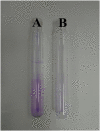The susceptibility of multidrug resistant and biofilm forming Klebsiella pneumoniae and Escherichia coli to antiseptic agents used for preoperative skin preparations at zonal referral hospital in Mwanza, Tanzania
- PMID: 34422235
- PMCID: PMC8360282
- DOI: 10.4314/mmj.v33i1.9
The susceptibility of multidrug resistant and biofilm forming Klebsiella pneumoniae and Escherichia coli to antiseptic agents used for preoperative skin preparations at zonal referral hospital in Mwanza, Tanzania
Abstract
Background: Non-susceptibility of bacteria to antiseptic agents used for preoperative skin preparations threaten the effectiveness of prevention of surgical site infections. Data concerning susceptibility of multidrug resistant bacteria strains to antiseptic agents was limited at our setting. This study presents the susceptibility of extended spectrum β-lactamases producing Klebsiella pneumoniae and Escherichia coli (with and without biofilm formation) to antiseptic agents used for preoperative skin preparations at zonal referral hospital in Mwanza, Tanzania.
Methods: This cross-sectional descriptive study was conducted through July 2020. Presumptive extended spectrum beta-lactamase producing Klebsiella pneumoniae and Escherichia coli were recovered for this study. Disc combination method was used to confirm production of ESBL while tube method was used to detect biofilms formation. Then, isolates were tested for susceptibility towards 10% povidone iodine, 70% methylated spirit, 50% hydrogen peroxide (6% of industrial H2O2 diluted in equal volume with sterile distilled water) and 2% chlorhexidine. STATA software version 13.0 was used for data analysis.
Results: A total of 31 presumptive ESBL producers were recovered and phenotypically confirmed, whereas 54.8% (n=17) were K. pneumoniae and 45.2% (n=14) were E. coli. Five (35.7%) E. coli and seven (41.2%) K. pneumoniae had positive biofilms test results. Four (12.9%) bacteria were non-susceptible to antiseptic agents used for preoperative skin preparations. However, none exhibited resistance towards 10% PVP-I.
Conclusion: In this study we highlight the existence of multidrug resistant Gram-negative bacteria with resistance to antiseptic agents used for preoperative skin preparation at a zonal referral hospital in Mwanza, Tanzania.
Keywords: Escherichia coli; Klebsiella pneumoniae; antiseptic agents; biofilms; extended spectrum beta-lactamases; multidrug resistance; surgical site infections.
© 2021 The College of Medicine and the Medical Association of Malawi.
Figures


References
-
- Kaiser Gary. An Overview to Control of Microorganisms. 2019;2020 Libretexts.
-
- Fair Richard J, Tor Yitzhak. Antibiotics and bacterial resistance in the 21st century. Perspectives in medicinal chemistry. 2014;6:S14459. PMC. Francesca Prestinaci, Patrizio Pezzotti, and Annalisa Pantosti, “Antimicrobial resistance: a global multifaceted phenomenon,” Pathogens and global health 109 (7), 309-318 (2015) - PMC - PubMed
-
- Gudapuri L. Cross-resistance between antiseptic agents and antimicrobial agents. J Epidemiol Infect Dis Cross Resist. 2017;1(2):00009.
MeSH terms
Substances
LinkOut - more resources
Full Text Sources
